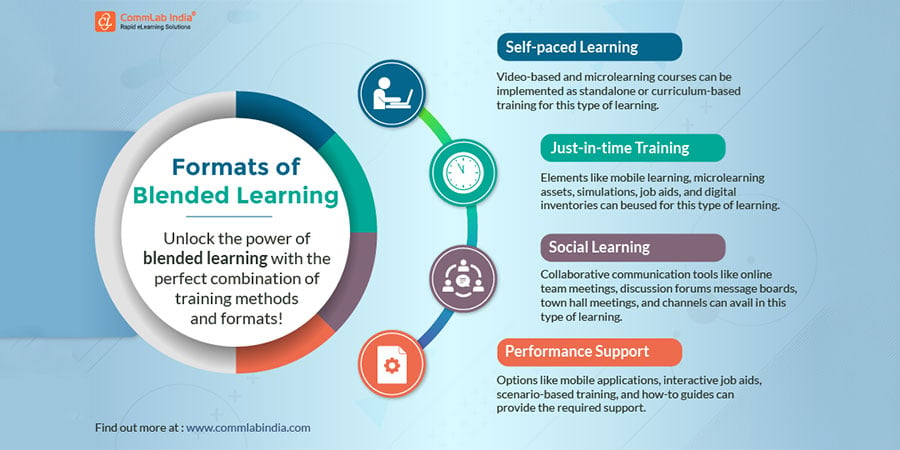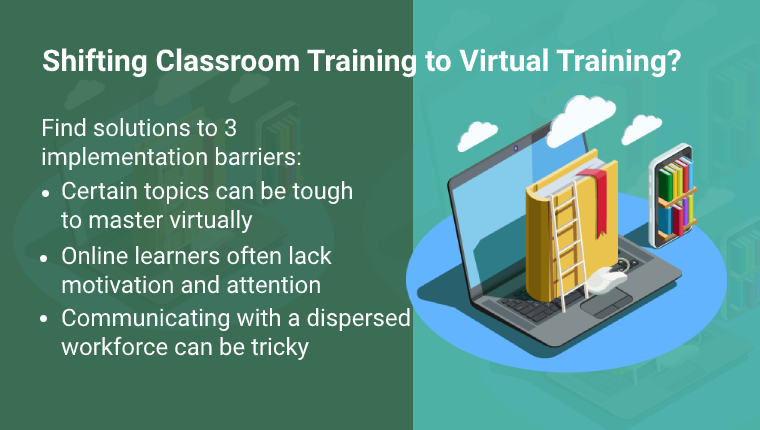Top 5 Instances Where Blended Learning Approach Works the Best

It’s no secret that blended learning is a highly successful and commonly utilized business form of training. Its most significant advantages are that it combines ILT (Instructor-Led Training) with online learning to provide training that is both quicker and more effective.
Organizations are no longer limited to employing only instructor-led or eLearning in the classroom. Blended learning combines traditional face-to-face instruction with online learning to give learners the best of both worlds. Is there, however, a certain training situation where blended learning should be introduced? Is it applicable to all types of training? Let’s explore that in this blog.
When Does Blended Learning Work Best?
Here Are 5 Factors to Ensure Successful Blended Learning:
- When There’s a Lot to Say but Not a Lot of Time
- When Various Stakeholders and Learners Need to Work Together
- When You Have Personnel That Are Geographically Distributed
- When You Need to Teach Personnel on a Regular Basis
- When You Wish to Make a Long-Term Career Strategy
Advantages of Blended Learning
The advantages of blended learning for businesses are numerous. Here are some of the ways it succeeds in making an impression:
- Not every learner processes information in the same manner. Blended learning allows corporate learners in the twenty-first century to complement their learning on their own time.
- Offering a classroom element and an online portion of the training provides accessibility for folks who may have scheduling difficulties or work remotely.
- The relative ease with which mobile devices—smartphones, tablet pcs, and laptops access courses expands the number of venues where learning may take place.
- Having access to training materials outside of the classroom helps learners to review and reinforce their knowledge outside of regular training sessions.
- In addition, because training materials may be accessed at any time and from any location, supplemental learning can be done at the learner’s leisure.
→ Download Now: Blended Learning: A Guide to Boost Employee Performance
Now that you know the advantages, it’s time to know about the blended learning formats. So here’s an informative infographic just for you!

Although it may be tempting to deploy blended learning right away, there are several circumstances in which it is most effective. This post will go over the many instances in which blended learning works best, so think about them before you rush the gun.
5 Situations Where Blended Learning Works the Best
1. When There’s a Lot to Say but Not a Lot of Time
Some training programs take longer because they demand a more in-depth study of the subject. Consider a pharmaceutical sales training course. These sales reps should be taught about pharmaceutical standards and regulations for selling pharmaceutical goods, as well as effective selling strategies and, of course, a basic understanding of pharmacological science and associated terminology, which is crucial when communicating with physicians.
With only one training style, the training will take several weeks to complete. You can cut your training time in half using blended learning. To maximize learning, a combination of face-to-face classroom-based training and online training programs is used to meet distinct phases of learning. Other training programs, notably in the insurance and manufacturing industries, as well as sales training, especially when dealing with complicated items, are similarly appropriate.
2. When Various Stakeholders and Learners Need to Work Together
Choosing a time for training that is suitable for all the stakeholders is one of the issues with traditional training techniques. It’s never simple to find a time that works for both the trainer and the participants, especially if they’re from various parts of the company or even divisions. In addition, you may be responsible for venue and lodging arrangements. In such cases, it is advisable to go for blended solutions that minimize face-to-face encounters. It saves you a significant amount of time and money.
3. When You Have Personnel That Are Geographically Distributed
The reach of classroom training programs is limited. There is a limit to how many people you can accommodate. That isn’t to say that others in the company don’t require training. For practical considerations, they are just denied. When you choose a blended learning approach, this does not have to be the case. You can enroll more personnel, especially those who operate in distant and far-flung locations. With ongoing learning opportunities, they will feel involved and supported.
For example, despite the fact that VILT sessions are given via virtual platforms, they are exact replicas of in-person training. Virtual classroom apps include live chat forums, Q&A sessions, games, and online surveys, to name a few social learning features. They can help businesses close skills gaps faster and in a more dynamic environment, as well as foster collaborative and social learning. Check out the video below to know some amazing VILT tools that are definitely worth a try!
4. When You Need to Train Personnel on a Regular Basis
Employee turnover is considerable in some industries, such as retail or the contact center industry. Every month, a significant number of new employees would join the company. Imagine having to offer them classroom training just to have them depart the company after a few months.
For salespeople to make the correct pitch, they must have a thorough understanding of the product. You have to make sure your salespeople make the correct pitch depending on the customer’s needs while they’re managing several products in the product line. Keeping this in mind, it’s important that when new items are introduced, personnel are taught on a regular basis to ensure that they have a thorough understanding of them. This can be done through microlearning by using micro modules. Check out the infographic below to understand the gist of microlearning.

In such cases, online training is preferable, as it reduces the requirement for face-to-face instruction to a minimal minimum – perhaps only hand holding by a direct supervisor. Because digital learning resources are generated once and may be utilized by employees over and over again, thus blended learning is cost-effective.
5. When You Wish to Make a Long-Term Career Strategy
Providing workers with career advancement possibilities is a solid technique when you want to invest in them for the long run. It means you may give employees a set of courses to take, and once they’ve completed each level, they’ll be promoted to the following band/level within the company. The employee will be responsible for finishing the course.
All you must do now is create an online curriculum and a career advancement plan and inform employees about their options. When everything is on the Learning Management System, it becomes highly organized and transparent. This is difficult in a traditional classroom setting, but it is quite achievable in a hybrid setting. Through this learning will become a journey rather than an event in the organization.
Usage of learning analytics may help you keep track of your learners’ progress, provide timely feedback, and conduct frequent evaluations. Learning analytics is the process of gathering, measuring, analyzing, and reporting data on learners and their settings to better understand and enhance learning and the environments in which it takes place. Learning analytics may help organizations improve their performance by reporting learner data that can be utilized to improve existing training programs or create new ones.
Parting Thoughts!
Blended learning improves information retention and skill development while also providing a strong return on your training expenditure. It is advantageous to learners and cost-effective for businesses. If you still have a lot of unanswered concerns regarding how to create the best-blended learning solution. It entails a thorough examination of the tasks that employees must be instructed on, as well as the most effective instructional methods to use.
This practical approach to blended learning provides answers to these issues. This eBook is a wonderful place to start if you wish to adopt this tried-and-tested corporate training method!
Editor’s note: This post was originally published in June 2022 and has been updated for comprehensiveness.





